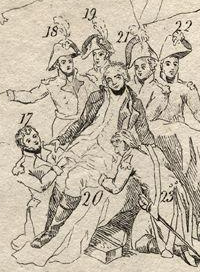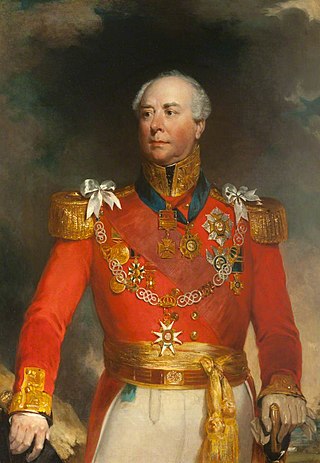Related Research Articles

The Hundred Days, also known as the War of the Seventh Coalition, marked the period between Napoleon's return from eleven months of exile on the island of Elba to Paris on 20 March 1815 and the second restoration of King Louis XVIII on 8 July 1815. This period saw the War of the Seventh Coalition, and includes the Waterloo Campaign, the Neapolitan War as well as several other minor campaigns. The phrase les Cent Jours was first used by the prefect of Paris, Gaspard, comte de Chabrol, in his speech welcoming the king back to Paris on 8 July.

HMS Minden was a Royal Navy 74-gun Ganges-class third-rate ship of the line, launched on 19 June 1810 from Bombay, India. She was named after the German town Minden and the Battle of Minden of 1759, a decisive victory of British and Prussian forces over France in the Seven Years' War. The town is about 75 km away from Hanover, from where the House of Hanover comes—the dynasty which ruled the United Kingdom from 1714 until 1901.

Commodore Sir William James, 1st Baronet was a Welsh naval officer and politician who sat in the British House of Commons representing West Looe from 1774 to 1783. James is best known for his career in India, where he served as an officer in the Bombay Marine, the navy of the East India Company (EIC), and led several successful campaigns against forces commanded by the Angre family.

Harpadon nehereus, is a species of lizardfish. Adults may reach a maximum length of 40 cm (16 in), but the usual size is around 25 cm (10 in).

Lieutenant-General Sir John Abercromby or Abercrombie GCB was a British Army officer and Member of Parliament (MP) for Clackmannanshire from 1815 to 1817.

General James Stuart (1741–1815) was a British Army officer who served in North America during the American Revolutionary War and took part in various campaigns in British India. He was the first General Officer Commanding, Ceylon and second Military Governor of British Ceylon. He was appointed on 1 March 1796 and was Governor until 1 January 1797. He was succeeded by Welbore Ellis Doyle.
The Fencibles were British regiments raised in the United Kingdom, Isle of Man and in the colonies for defence against the threat of invasion during the Seven Years' War, the American War of Independence, the French Revolutionary Wars, the Napoleonic Wars and the War of 1812 in the late 18th and early 19th centuries. Usually temporary units, composed of local recruits and commanded by Regular Army officers, they were usually confined to garrison and patrol duties, freeing Regular Army units to perform offensive operations. Most fencible regiments had no liability for overseas service.

The Bombay Army was the army of the Bombay Presidency, one of the three presidencies of British India.

General Sir Archibald Campbell, 1st Baronet was a Scottish soldier who served as an officer in the British Army. From 1824 to 1826, Gen. Campbell commanded the British forces in the First Anglo-Burmese War, the longest and most expensive war in British Indian history, that gave the British control of Assam, Manipur, Cachar, Jaintia, Arakan and Tenasserim. He became known as the "Hero of Ava". From 1831 to 1837, he was the administrator of the colony of New Brunswick, Canada. The Canadian city of Campbellton in the province of New Brunswick was named in his honour.
George Barnes, D.D. was an English churchman, the Archdeacon of Barnstaple from 1830 to 1847.

Ceylon was an East Indiaman launched in 1803. She performed four voyages for the British East India Company (EIC). On her fourth voyage the French captured her in the action of 3 July 1810; she then took part in the Battle of Grand Port. The British recaptured her at the invasion of Île de France. She completed her fourth voyage and her owners then sold her. She became a transport until her owners sold her in 1815 to new foreign owners.
Varahi is a village in Santalpur taluka of Patan district of Gujarat state of India.
Cornwallis was built probably at Surat around 1789, or possibly Demaun in 1790. Her name was originally Britannia, but it was changed to Cornwallis shortly before her completion. She served for some years in India as a country ship, before transferring her registry to Britain in 1797. She then served in private trade between Britain and India until 1809 or so when she transferred her registry back to Bombay. Thereafter she served as a country ship, though in both 1810 and again in 1817 she performed a voyage to Britain for the British East India Company. Thereafter she apparently continued to serve as a country ship with homeport of Bombay. She burnt there in June 1841 as she was about to take a cargo of cotton to China.
Milford was built at Bombay in 1786 for Pestonjee Bomanjee and John Tasker. She was a country ship that traded around India and between India and China, though she also traded with England. She made one voyage for the British East India Company (EIC). She was lost at Calcutta in August 1829.
Regret was launched at Whitby in 1814. She traded with the East Indies under license from the British East India Company (EIC). She also made one voyage for the EIC. A fire destroyed Batavia Roads in September 1822.
Union was launched at Calcutta in 1801. She sailed to England and then made five voyages as an East Indiaman for the British East India Company (EIC), between 1805 and 1814. She was wrecked in late 1815 or early 1816.

HMS North Star was a ship launched in 1810 and spent much of her naval career on the Jamaica Station. The Navy sold her in 1817 and she became the merchantman Columbo. Columbo sailed between Britain and India under a license from the British East India Company (EIC) until she was damaged in 1822 while returning from Ceylon. She was condemned at Point de Galle and sold there for breaking up.

The Persian Gulf campaign of 1819 was a British punitive expedition, principally against the Arab maritime force of the Al Qasimi in the Persian Gulf, which embarked from Bombay, India in November 1819 to attack Ras Al Khaimah. The campaign was militarily successful for the British and led to the signing of the General Maritime Treaty of 1820 between the British and the Sheikhs of what was then known as the "Pirate Coast", would become known as the "Trucial Coast" after this treaty. Today, the territory comprises much of the United Arab Emirates.
David Scott was launched at Bombay in 1801. She was a "country ship", i.e., she generally traded east of the Cape of Good Hope. Between 1802 and 1816 she made five voyages between India and the United Kingdom as an "extra ship" for the British East India Company (EIC). Thereafter she traded between Britain and India under a license from the EIC. A fire destroyed her at Mauritius on 12 June 1841.

Asia was built at Bombay Dockyard in 1797. She made at least two voyages for the British East India Company (EIC) before the British Royal Navy purchased her in 1805 in the East Indies. The Royal Navy renamed her HMS Sir Francis Drake and used her as a frigate. She served in the Java campaign of 1811. When she returned to England in 1813 she was refitted as a storeship. Later, she became the flagship, at Newfoundland, for the governors of Newfoundland. The Admiralty sold her in 1825. New owners renamed her Asia and she sailed between Britain and London until 1831 when Portuguese interests purchased her. She then became the frigate Dona Maria II for the Liberal forces that were attempting to install the rightful queen, Dona Maria II, to the throne of Portugal, and overthrow Dom Miguel, who had usurped the throne. In early 1849 conflict developed between the Portuguese government in Macau and the Chinese government over who could collect taxes and tariffs at Macao. Dona Maria II sailed to Macao as part of a small squadron. An internal explosion destroyed her in the harbour on 29 October.
References
- ↑ The Parliamentry Register. 1791. p. 524.
- ↑ The Bombay Almanack and Register. 1798. p. 54.
- ↑ The Scots Magazine. 1 January 1815. p. 720.